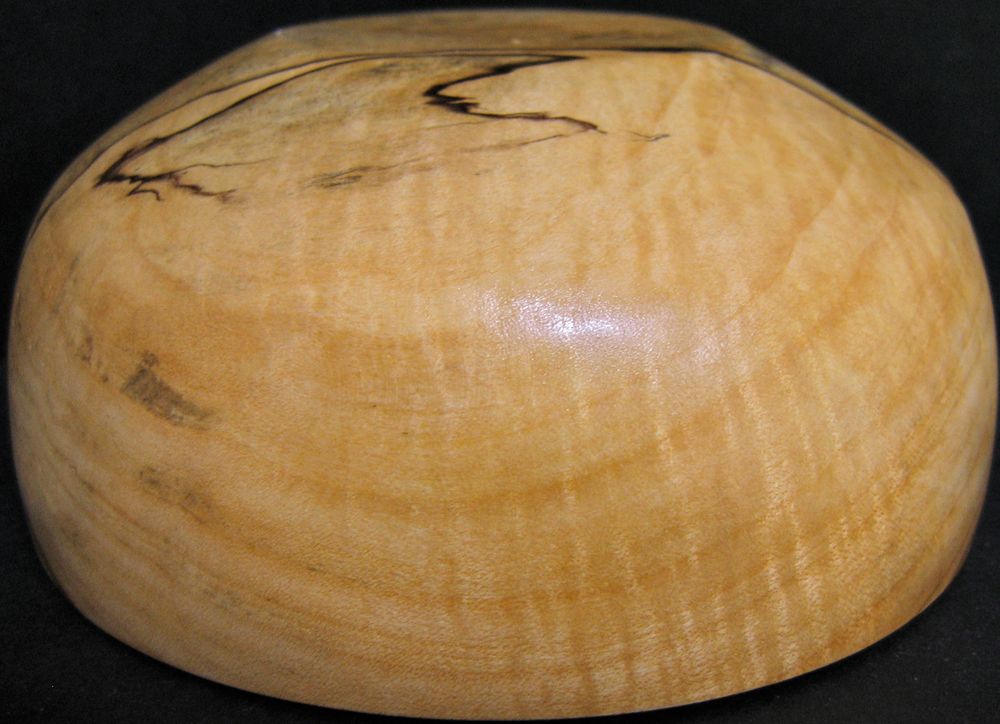Spalted Lumber: The deeper meaning of zone lines
It pretty much all boils down to one word: WAR!
White rot wins? The bluestain was efficiently stopped, but the white rot never colonized. Perhaps too many of its resources went into building defenses.
While spalting can be any coloration of wood caused by fungi, the winding black zone lines commonly seen on punky wood are what most think of when discussing spalting. At a recent gallery reception for my spalted work, I had the privilege of explaining zone lines, and just what they can tell us about fungi. It pretty much all boils down to one word: WAR!
Zone lines are a ‘wall’ caused by a fungus trying to protect its resources. In general, you cannot get zone lines on a piece of wood without at least two different fungi present. The zone line is formed by one of the fungi when it finds out another fungus is coming after its hard-won land. However, this doesn’t mean that every fungus will put up a zone line when it meets another; both fungi must be of comparable strength. A quick and aggressive fungus attacking the resources of a weak fungus will simply overrun the weaker, no zone lines required.
So how do you manage to find two equal strength fungi? Trial and error works, however most Basidiomycetes (the actual wood decay fungi) are quick and strong colonizers, and are good matches for each other. Be careful with Trametes versicolor (Turkey Tail) though, this fungus is incredibly strong and quick, and will overtake most other Basidiomycetes.
Some fungi can form zone lines by themselves, although no one is quite sure just how many of the fungi can do this. Xylaria polymorpha (Dead Man’s Finger) and Trametes versicolor (Turkey Tail) are both capable of producing their own zone lines, although Xylaria polymorpha produces them with far more regularity. Why do they produce walls if no one else is around? You might at first assume some sort of fungal paranoia, but it turns out that fungi like Trametes versicolor mutate very quickly, and new mutants are unable to play nicely with their brothers and sisters. The result? Zone lines formed from only one fungus that can’t quite seem to figure itself out! (Those interested in the hard science behind intraspecific antagonism should look into Rayner’s work.)
Now, whenever you see a zone line, think about the story the fungus can tell you. In this basswood bowl, there is is only one strong zone line.

Notice how the bluestain on the top half is complete sequestered from the rest of the bowl. Also noticed the apparent lack of fungal colonization on the bottom half. A good guess would be that the bottom half was colonized by a Basidiomycete white rot fungus, and the top half by one of the millions of bluestain fungi. Both grew at similar rates and met in the middle of the bowl. WAR! The white rot quickly put up defenses to block the bluestain’s advances.
The story doesn’t end there. Most white rots are very destructive to wood. They bleach the wood white and leave spongy, punky areas. The bottom portion of this bowl was sound and only slightly bleached. With all resources sent to the front lines, it is unlikely that the white rot fungus had enough energy left to begin serious colonization. In terms of this war, I’d call it a stalemate. The bluestain may have been cut off, but it got far more colonization accomplished than the white rot.
Fine Woodworking Recommended Products

Ridgid R4331 Planer

AnchorSeal Log and Lumber End-Grain Sealer

DeWalt 735X Planer




























Comments
So--I like the looks of zone lines, but now I'm not sure if they're a good thing or not. Do they weaken the wood as they decorate it?
Nancy
In general, zone lines indicate white rot decay. So in that sense, yes, wood with zone lines is much weaker than sound wood. Unless you have intentionally spalted your wood with Dead Man's Finger, which is only slightly destructive, its a good bet that some areas of the wood are very punky.
Never fear however! While zone lined wood found outside may be too soft to turn, most anything you spalt at home will still be mostly sound if you've controlled the conditions well.
Fantastic write up, it give so much more meaning to spalted wood. I have found by best pieces at the local brush pile. Is there any way to generally classify the fungus by discoloration? Great work.
Cheers,
Nicholas
http://www.nicholastinney.com
Is there any way to generally classify the fungus by discoloration?
Yes, but the key word here is 'generally'. Bleaching is caused mostly by basidiomycete (wood decay) fungi, so if you see punky white areas, you can hold fungi like Turkey Tail as suspect. Pigments are usually from ascomycetes, and depending on the color, you might be able to narrow it down a little more. For instance, there is only one genus that makes the blue-green color: Chlorociboria. It is mostly Ceratocystis and Ophiostoma fungi that make blue stain.
For zone lines, you're out of luck. Many, many fungi have the capacity to produce them either alone or from external antagonism. So unless you see Dead Man's Finger growing somewhere near the wood, you really have no way of knowing what caused the zone lines.
Happy spalting!
Log in or create an account to post a comment.
Sign up Log in